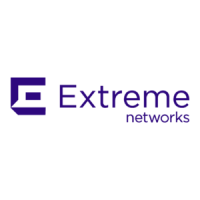Managing the Switch
ExtremeWare XOS 11.3 Concepts Guide
84
Accessing Switch Agents
To access the SNMP agent residing in the switch, at least one VLAN must have an assigned IP address.
By default, SNMP access and SNMPv1/v2c traps are enabled. SNMP access and SNMP traps can be
disabled and enabled independently—you can disable SNMP access but still allow SNMP traps to be
sent, or vice versa.
Supported MIBs
In addition to private MIBs, the switch supports the standard MIBs listed in Appendix D.
Configuring SNMPv1/v2c Settings
The following SNMPv1/v2c parameters can be configured on the switch:
● Authorized trap receivers—An authorized trap receiver can be one or more network management
stations on your network. The switch sends SNMPv1/v2c traps to all configured trap receivers. You
can specify a community string and UDP port individually for each trap receiver. All community
strings must also be added to the switch using the
configure snmp add community command.
To configure a trap receiver on a switch, use the following command:
configure snmp add trapreceiver <ip_address> community [[hex <hex_community_name>]
| <community_name>] {port <port_number>} {from <src_ip_address>} {mode <trap_mode>
[enhanced | standard]}
You can delete a trap receiver using the
configure snmp delete trapreceiver command.
Entries in the trap receiver list can also be created, modified, and deleted using the RMON2
trapDestTable MIB table, as described in RFC 2021.
● Community strings—The community strings allow a simple method of authentication between the
switch and the remote network manager. There are two types of community strings on the switch:
■ Read community strings provide read-only access to the switch. The default read-only
community string is public.
■ Read-write community strings provide read- and-write access to the switch. The default read-
write community string is private.
● System contact (optional)—The system contact is a text field that enables you to enter the name of
the person(s) responsible for managing the switch.
● System name (optional)—The system name enables you to enter a name that you have assigned to
this switch. The default name is the model name of the switch (for example, BD-1.2).
● System location (optional)—Using the system location field, you can enter the location of the switch.
Displaying SNMP Settings
To display the SNMP settings configured on the switch, use the following command:
show management
This command displays the following information:
● Enable/disable state for Telnet and SNMP access
● Login statistics

